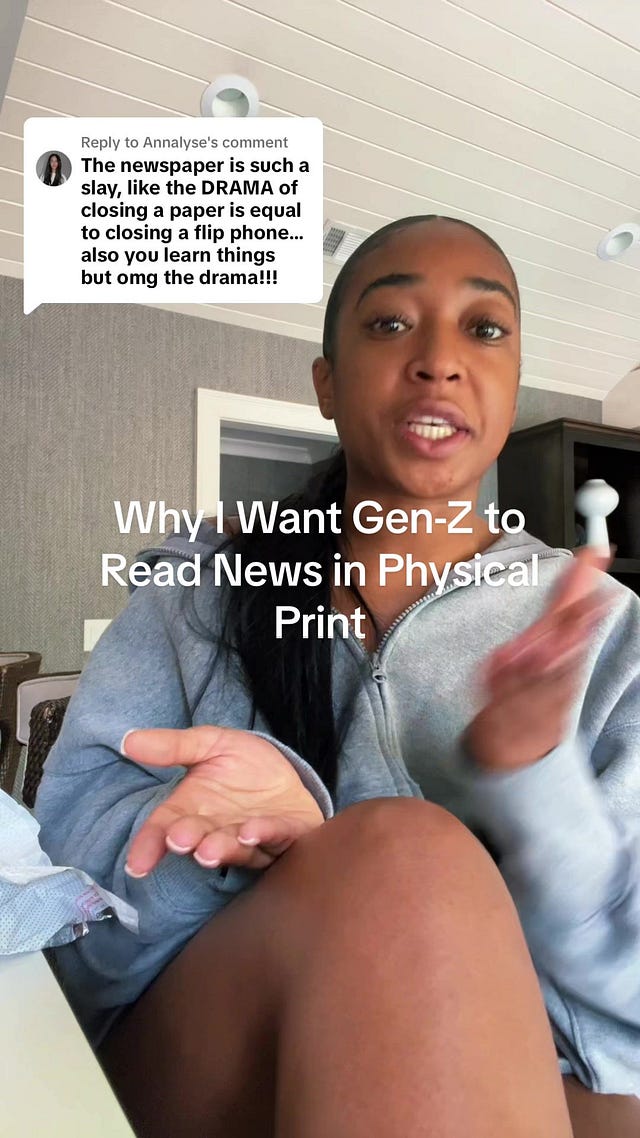TikTok ‘media literacy influencer’ makes newspapers fun
She aims to promote curiosity among young people

Growing up reading the metro and arts sections of The Atlanta Journal-Constitution during breakfast, Kelsey Russell turned to reading newspapers in her twenties to rediscover that childhood joy.
“My therapist suggested to help with anxiety, finding things that made me happy,” said Russell, a student at Teachers College, Columbia University. “I remember how much I used to love almanacs.”
Thus, for her 23rd birthday, she asked her parents for a subscription to The New York Times.
With around 44,000 followers on TikTok at that time, she decided to create videos based on her daily reading of The Times, emphasizing the importance of newspapers for Gen Z.
Her first video has garnered more than 1.7 million views and received praise from journalists, newsrooms, educators, lawyers and legislators.
“I think my goal is to promote curiosity,” Russell said, explaining that she wanted young people to know what the best questions to ask and to engage in discussions about current affairs.
Apart from The Times, Russell has created videos about publications such as The Wall Street Journal, The Washington Post, The Constitution, The Charlotte Observer, USA Today and The Tampa Bay Times.
AP-NORC Center poll showed 39% of Gen Z consume news daily from traditional sources, including newspapers, TV news stations and their apps and websites.
While 18% of Gen Z pay for at least one news product, according to the poll, only 9% of them pay for digital or print newspapers.
Another number from Pew Research Center shows that the share of news consumers on TikTok has nearly doubled since 2020.
Russell’s videos, which run approximately five to eight minutes, delve into specific news stories, breaking down what occurred and why it is vital to stay informed.
For instance, in a video about the raid at Marion County Record in Kansas, Russell explained the importance of the First Amendment and the lack of press freedom in other parts of the world.
“First, I learned something that I didn’t know,” Russell said. “The article allows me to discuss other social topics, like using the article to ask probing questions, and then it’s actually trying to pick a concept that I know people are a little unfamiliar with.
“I’ll go the extra mile to look up the word for you and explain it so now you feel more comfortable interacting with that,” she continued.
That’s why Russell felt the need to read newspapers in the first place. She said she needed to grasp what was going on in the world so she could understand what people around her were talking about.
Asked why print newspapers appeal to her, Russell said, unlike online media, they allow her to dedicate a portion of her day to focus on learning about the world.
It’s also an ego thing, she jokingly said.
“I wanted to live in New York and I wanted to be able to go to the park and read my newspaper or be on the train and read my newspaper,” Russell said. “I wanted to look different. You know what I mean, I would look cuter.”
The response to her TikTok initiative has been positive.
She said teachers see her video as “an opportunity to invigorate curiosity” in their classrooms, journalists are hopeful at the idea of “the next generation being invested in journalism,” and lawyers and legislators are interested in the promotion of First Amendment protection.
Russell also got a tour of The Times and gift subscriptions from various newspapers.
 Tiktok failed to load.
Tiktok failed to load.Enable 3rd party cookies or use another browser
Newspapers ‘are biased in their own ways’
As a self-proclaimed “media literacy influencer,” Russell said none of the news outlets are “that reliable” when asked about how she makes judgments on what to trust.
“What I take note in is that what I’m consuming on social media is so drastically different from what I’m reading in the newspaper,” she said, especially when it comes to wars.
While recognizing the journalistic process that journalists undertake before publishing, Russell pointed to the challenges of fact-checking in certain communities and the pressure of deadlines, which can result in biased reporting.
Singling out the coverage of the latest Israel-Hamas war, Russell said: “You can be as mad as you want at The New York Times, but that’s a product of years of policies and wars that don’t allow their writers to get the view of another person, and they have to meet a deadline.”
Given that, Russell emphasized her TikTok isn’t about getting people caught up with current events because she doesn’t want to make a video about “a very biased source.”
“I’m promising you that you’re going to leave more curious and maybe ask a question about a current event to somebody,” she said.
What I’m reading:
Your local newspaper might not have a single reporter — The Wall Street Journal
Representation of Asian, Black and Hispanic staffers grows at public media stations — Current
How New York Times designed journalism audio app from the ground up — The NYT Open Team (Medium)
How TMZ became Hollywood’s Grim Reaper — The Hollywood Reporter
A new model for digital media? What Karlie Kloss’s acquisition of i-D means — The Guardian
Trump’s Truth Social sues 20 news outlets over financial loss reports — Business Insider





